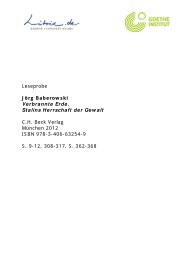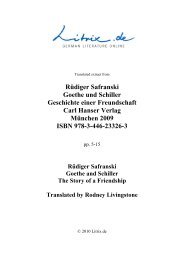Axel Brüggemann / Monika Horstmann (Illustratorin) Wie Krach zur ...
Axel Brüggemann / Monika Horstmann (Illustratorin) Wie Krach zur ...
Axel Brüggemann / Monika Horstmann (Illustratorin) Wie Krach zur ...
Create successful ePaper yourself
Turn your PDF publications into a flip-book with our unique Google optimized e-Paper software.
Translated extract from<br />
<strong>Axel</strong> <strong>Brüggemann</strong> /<br />
<strong>Monika</strong> <strong>Horstmann</strong> (<strong>Illustratorin</strong>)<br />
<strong>Wie</strong> <strong>Krach</strong> <strong>zur</strong> Musik wird.<br />
Die etwas andere Musikgeschichte<br />
Beltz & Gelberg Verlag<br />
Weinheim 2010<br />
ISBN 978-3-407-75353-3<br />
pp. 179-183<br />
<strong>Axel</strong> <strong>Brüggemann</strong> /<br />
<strong>Monika</strong> <strong>Horstmann</strong> (Illustrator)<br />
How Noise Becomes Music<br />
Translated by Gratia Stryker-Härtel<br />
© 2011 Litrix.de
Ancient sounds – Music is child’s play<br />
From primal scream to music – How sound is rooted deep within us<br />
Melody is a magic trick – The mystery of nice notes<br />
Bah-bah-bum – How rhythm moves us<br />
Age-old instruments – The flute from Ulm<br />
The unspeakable – Conductor Daniel Barenboim tries to explain what music is<br />
The world is sound – Music in antiquity<br />
The sounds of God in the Middle Ages – From monks to minnesingers<br />
Singing churches – The first rules of music<br />
Notating sound (Part One) – How musical scores came to be<br />
Heavenly choirs – And the monks rejoiced<br />
Notating sound (Part Two) – The notes receive their names<br />
How does love sound? The art of the Minnesang<br />
Music in flux – The Renaissance and the Baroque<br />
Story time – The printing press and the Reformation<br />
Building music – How sound is architecture<br />
Just how do you compose that? Major and minor<br />
Sung-out plays – The invention of opera<br />
A tale of atrocity – The singer Cecilia Bartoli on the artistry of the castrati<br />
Powdered wigs and curlicues – Baroque splendidry<br />
A tangle with power – Artists at the French court<br />
Georg Friedrich Händel, opera millionaire<br />
My search for the sound – Conductor Nikolaus Harnoncourt on the magic of historical instruments<br />
Canon and fugue – Bach and the science behind music<br />
www.goethe.de/litrix<br />
1
The human being in music – The Classical Period<br />
Classical enlightenment – A new way of thinking<br />
Haydn – The headless composer<br />
Little Amadeus? Three misconceptions about Mozart<br />
It’s not what you hear but how you hear it – What we hear that’s not there<br />
Genius – Ludwig van Beethoven<br />
Scads of scores – What does a conductor do?<br />
The love of my life – Violinist Daniel Hope on his instrument<br />
The eternal melody – Dream world of Romanticism<br />
Searching for truth – The soul of the Romantic<br />
And the world begins to sing – The art song<br />
Why little lieder make such great art – Singer Thomas Quasthoff on the voice and singing<br />
Liszt, Chopin and other keyboard artists – Great piano works<br />
That’s how home sounds – The great symphonies<br />
Genius or half-baked? Richard Wagner<br />
Dramas sung – Operas from Weber to Puccini<br />
Age of extremes – Modern music<br />
The cacophony of the contemporary – Mahler and Shostakovich<br />
Scandal at the opera – Richard Strauss<br />
A matter of ambiance – Impressionism<br />
Arnold Schönberg – Reinventing music?<br />
A new harmonic system – The math of the twelve tones<br />
Modern diversity – The century of “-isms”<br />
www.goethe.de/litrix<br />
2
From catastrophe to pop – New worlds of sound<br />
Degenerate, my foot – Music in Nazi Germany<br />
American opera – The musical<br />
Inspiration from afar – World music<br />
Newfound freedom – Jazz<br />
Computers and more, at the fore – The Avant-garde<br />
Who’s afraid of the opera? – New music, new sounds<br />
Celebrating the surface and shallow – Pop music<br />
Classical and rock – The singer Sting about the future of music<br />
Kaleidoscopic diversity of styles – The sounds of our time<br />
www.goethe.de/litrix<br />
3
From catastrophe to pop – New worlds of sound<br />
Degenerate, my foot – Music in Nazi Germany<br />
At the time when Adolf Hitler was voted in as chancellor of Germany’s Third Reich in 1933, a large<br />
number of people were jobless. Hitler had promised the people that things would be better for them if he<br />
were in power. Over and over again in his speeches, he had asserted that the Jews were at fault for the<br />
condition in which Germany found itself. And many Germans believed him. After Hitler was named<br />
“Führer” – dictator – and the Weimar Republic’s democratic form of government was dissolved, he began<br />
persecuting the Jews.<br />
He initially limited the scale of their humiliation, requiring them to wear a yellow star atop their clothing.<br />
This warranted all to note who was Jewish and who wasn’t. Jews were treated as second-class citizens,<br />
and their human rights were denied them. In the Kristallnacht of 1938, a large number of Germans<br />
destroyed Jewish businesses and houses. Books written by Jews were publicly burned. In the end, the<br />
Nazis resolved to kill all Jews in Europe, calling this genocide the “final solution.”<br />
After seizing power, Hitler began to expand the territory of the German Reich. He asserted that Austria<br />
belonged to Germany. He followed by occupying Czechoslovakia. In Italy, he entered into an alliance<br />
with Fascist dictator Benito Mussolini. Soon thereafter, German troops had conquered Poland and France.<br />
In just the blink of an eye, a large portion of Europe had slipped under Hitler’s domination.<br />
All occupied territories were combed through to find Jews. A ghetto was built in Theresienstadt to<br />
confine the Jews in Bohemia, one of those territories; and more and more German Jews were deported<br />
there too. At first glance, the ghetto looked like a village surrounded by a barbed wire fence. For the<br />
Nazis, the ghetto was known as a “transit camp,” a place where Jews were deported so that, sooner or<br />
later, they could be sent to concentration camps to be murdered. But many people died in Theresienstadt<br />
as well.<br />
One of the many imprisoned in Theresienstadt was Viktor Ullmann, a composer born in Czechoslovakia<br />
who went to Vienna to study with Arnold Schönberg. He later moved to Prague and studied under the<br />
mentorship of Alexander von Zemlinsky. A highly promising musician, Ullmann particularly liked<br />
employing quarter-tone steps in his music, and he created his own tonal language.<br />
It was in 1942 that Viktor Ullmann was deported to Theresienstadt. There he wrote short articles for the<br />
ghetto newspaper and organized concerts with other Jews. Ullmann did not want to believe that people<br />
were murdering each other. He did not believe that the Nazis had already gassed millions of Jews. But<br />
www.goethe.de/litrix<br />
4
over time, the rumors and the proofs of mass murders could not be avoided any longer. Ullmann even<br />
wrote an opera in the Theresienstadt ghetto. It bore the title “The Emperor of Atlantis,” and it centered on<br />
a mad emperor – an allusion, of course, to Adolf Hitler. The opera was not performed at the time.<br />
On October 16, 1944, the composer, alongside many other Jews in Theresienstadt, was herded into a<br />
cattle car. The train traveled directly to Auschwitz, into one of the largest German concentration camps.<br />
Ullmann was undressed, his hair was shorn, and he was forced into the gas chamber – and murdered<br />
there. The war came to an end seven months later; Germany surrendered after France, England, the USA<br />
and Russia conquered Adolf Hitler. But that was no longer of any use to Viktor Ullmann, victim of the<br />
“Shoah” – the genocide undertaken by the Nazis against the Jews.<br />
Hitler’s Nazis extinguished a large portion of German musical culture; and many artists killed by the<br />
Nazis were irreparably lost to memory after the war as well. It was more than thirty years after his death,<br />
in 1975, that Viktor Ullmann’s opera “The Emperor of Atlantis” was first premiered.<br />
Erwin Schulhoff was also among those who fell victim to the Holocaust. Before the war, Schulhoff was a<br />
musician with a penchant for experimentation. He became caught up in the winds of new musical<br />
movements, focusing especially on quarter-tone music, and he experimented with the jazz coming from<br />
the USA to Germany at the time. After Hitler came to power, Schulhoff foresaw the tragedy to come. He<br />
joined the ranks of the Socialists in opposition to National Socialism (Nazism). Schulhoff was confined in<br />
the Fortress of Wülzburg in Bavaria, in an internment camp for the citizens of foreign countries – and<br />
died a miserable death there due to malnutrition, exhaustion and illness.<br />
More than six million people were murdered by the Nazis, including not only Jews but also gypsies,<br />
homosexuals and many handicapped people and political opponents. Hitler also singled out artists who<br />
broke with the Nazi aesthetic.<br />
As dictator, Hitler not only wanted domination over all of Europe but also complete power over the arts.<br />
He held that poems, paintings and music should first and foremost be “German,” in the view that<br />
Germans were “Übermenschen,” a people better than all others. He raved about the operas of Richard<br />
Wagner since they portrayed German heroes. And he used art for his propaganda; Nazi films featured the<br />
well-formed, supposedly “Aryan” bodies of blonde, well-trained men and women. Filmmaker Leni<br />
Riefenstahl used them in the scenes of her films and sculptor Arno Breker cast them in stone.<br />
In their propaganda, the Nazis primarily used operettas, military marches and popular hits. In using them,<br />
they hoped to awaken strong feelings in their viewers and listeners. When German troops faced defeat in<br />
www.goethe.de/litrix<br />
5
Russia and it first began to look like Germany could lose the Second World War, Hitler’s propaganda<br />
minister Joseph Goebbels used films and music to encourage the people to keep going.<br />
Singer Zarah Leander and popular hit star Hans Albers were the most well-known artists to perform under<br />
Hitler’s swastika-bedecked flag and fire up the German population with their songs. Since the texts they<br />
performed were not really political, it is difficult to say if these artists were singing for Hitler or their<br />
public. Probably the most well-known song of the time was Lale Andersen’s “Lili Marleen,” which was<br />
about a woman waiting in lantern-light in front of some barracks for her husband. This song, of course,<br />
was a hit with the soldiers, hoping in the trenches that their wives back home were waiting faithfully for<br />
them. And, in a show that sometimes, music can even bind together people who are fighting against each<br />
other, “Lili Marleen” was loved not just by German soldiers but also by English and American soldiers as<br />
well.<br />
Nazi art, at its core, was pretty simple. It was designed to encourage people, to be pretty – and to fire<br />
people up for Germany and for Hitler’s politics.<br />
The Nazis despised everything that did not sound “normal” – and outlawed it. Particularly the art that had<br />
developed just before they seized power: Expressionism, Dadaism, Surrealism, Cubism and New<br />
Objectivity. They ridiculed the jazz coming from the USA under the name “Negermusik.” The Nazis<br />
drove out, imprisoned and murdered most of the musicians who had risen to success before their takeover.<br />
The Nazis had their own musical favorites, and they endured composers like Carl Orff, who especially<br />
experimented with rhythm in his works. Orff was also criticized by the Nazis, however, for his great<br />
choral work, “Carmina Burana,” a piece that was too “jazzy” for them. Orff, for his part, had used<br />
recomposed songs from the Middle Ages in the piece.<br />
Anything and everything that did not conform to Nazi ideals of beauty was slotted as “degenerate art” –<br />
art that posed an endangerment to society.<br />
In 1937, an exhibition of “degenerate artworks” of this sort was staged in Munich. The Nazis, in an effort<br />
to warn Germans against this “scandalous” culture, acted out in an especially malevolent way. They hung<br />
imaginative paintings of people next to photographs of handicapped individuals in mockery of both the<br />
handicapped and the artists participating in the exhibition. The absurd thing about this exhibition of<br />
“degenerate artwork”? Rarely in history have so many excellent modern artworks been on display in one<br />
place – and, sad to say, under the worst of circumstances.<br />
www.goethe.de/litrix<br />
6



![PDF anzeigen [65 KB]](https://img.yumpu.com/21718989/1/184x260/pdf-anzeigen-65-kb.jpg?quality=85)


![show PDF [5522 KB]](https://img.yumpu.com/21308533/1/184x260/show-pdf-5522-kb.jpg?quality=85)
![PDF anzeigen [36 KB]](https://img.yumpu.com/21240334/1/184x260/pdf-anzeigen-36-kb.jpg?quality=85)

![Mostrar PDF [68 KB]](https://img.yumpu.com/14286441/1/184x260/mostrar-pdf-68-kb.jpg?quality=85)






